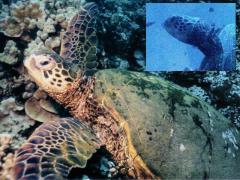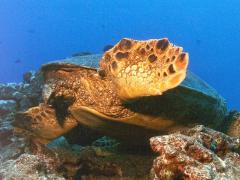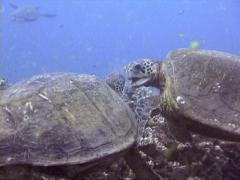McTaggert [1992 Turtle 35]
|
|
That was then (inset, 1992) and this is now (2003).
76K JPEG
|
| Quickstats: Seen 1992, nesting at French Frigate Shoals 1993, 1994, 1995 (74K JPEG), 1997 (59K JPEG), 1998 (69K JPEG), nesting at French Frigate Shoals 1999, 2000 (63K JPEG), 2001 (70K JPEG), 2003. |
Summer updates: 1996, 1997, 1998, 1999, 2000, 2001, 2002, 2003, 2004. |
1992 Turtle 35 started out as an also-ran turtle. Back in 1992, she was nothing more than a left profile in a poor photo, as you can see from the insert in the image above. We did not even officially identify her until 1994, when we photographed a tagged turtle and compared previous photographs and video images.
In 1992, we saw this turtle only once, shrinking in the distance. In 1994, she was much more tolerant of approach. She was also a regular visitor to the Turtle House. We named her McTaggert in honour of the tags she wore. Since our logs had no mention of seeing tags on her in '92, we assumed that her absence in 1993, coupled with shiny tags that appeared to be new, meant that she had been away nesting at the French Frigate Shoals.
McTaggert was so trusting we easily read her tag numbers. In fact, McTaggert was at the Turtle House when George Balazs dived with us. He read the tags himself and confirmed McTaggert sports tags numbered F-765 and F-766. She is healthy and free from visible tumors.
In 1995, we sighted her infrequently, but when we did she did not seem disturbed at all by our presence or approach. She allowed us to get photos of her that were good enough to confirm her 1995 attendance at Honokowai reef and her apparent good health. We won't be surprised if we don't see her in '96, since she might be at the French Frigate Shoals. Green turtles nest every 2 or 3 years, and we are not yet sure of McTaggert's nesting cycle.
We did not see McTaggert in 1996. It is quite possible that she was nesting at the French Frigate Shoals, since she last nested in 1993.
We first sighted McTaggert on our seventh dive on the afternoon dive of July 3rd. Although we had not seen her since 1995, our good friend remembered us and let us get all the photo documentation we wanted.
The good news is that it looked like McTaggert had grown considerably both in length and girth. She’d become quite confident, and carried on normal activities even when we were both very close to her.
The other good piece of news is that she still appeared healthy and free from any hints of fibropapilloma disease. She remains one of the lucky Honokowai regulars. She's been around since 1992 and has managed to steer clear of the disease all that time.
Our fondest memory of her was being allowed to spend about ten full minutes of a dive just watching and photographing this large female while she had a major itch going on.
|
|
She would repeatedly draw her plastron back and forth, her rear feet flailing all the while
75K JPEG
|
Using her front flippers, should would maneuver herself over a rock outcropping. Then she would repeatedly draw her plastron back and forth, her rear feet flailing all the while. One of our favourite photos for 1997 shows McTaggert at her most enthusiastic best on that particular itch'n'scratch session.
McTaggert didn't take long to put in an appearance. We first sighted her on July 9th and we didn't immediately recognize our old friend. She swam in towards The Rock and we could see her from the right. Her complete disinterest in us suggested this was a turtle we should know (it's clear she knew us!)
Only when she swung around to land, revealing her left facial markings, did we recognize McTaggert. In some ways we were surprised to see her. We half expected her to be taking the summer to nest at the French Frigate Shoals.
We got very close to her and were able to take excellent video. We only saw her twice in Summer 98 and there's little to report. A good thing actually, when all around you are turtles affected by fibropapilloma. McTaggert appears to have remained free of the disease since we first met her in 1992.
Yet a quick look at our field notes reveals this:
...then ultraclose right swimby and can see a possible pinprick #1 in RIGHT EYE 98Tape5 @ 1:37:38
The phrase "possible pinprick #1" means there's video evidence she might have a tiny emerging tumor in her right eye. Even though we got 'ultraclose', we couldn't confirm a tumor.
We really don't expect to see her in Summer 1999--we expect her to make a nesting migration. We've notified George Balazs of the US National Marine Fisheries to be aware that McTaggert (F765) might be nesting at East Island.
Whether we see her at Honokowai, or she shows up at East Island with the dedicated volunteers there, we should know for sure the condition of her right eye in 1999. Presently we have her listed as "FP suspected."
We hope we don't have to report her 1999 status as "FP confirmed."
As we wrote in 1998 (above), when the 1999 nesting season approached, we notified George Balazs that McTaggert might be at the French Frigate Shoals this summer. After we'd been diving about two weeks and hadn't sighted her, we were pretty sure we'd get confirmation from George that she'd been sighted at the Shoals. We didn't have to wait long:
Date: Tue, 13 Jul 1999 12:12:44 -1000 (HST)
From: "George H. Balazs"
Subject: turtles
Sorry, U521 not seen. However your McTaggert F765 and F766 was
there nesting this season.
We'd hoped the turtle would return home in time for us to resight her and relieve us of having to fret whether she made it back to Honokowai safely. We have no doubt that Honokowai is the destination of our nesting females. If they are alive they come home--but the open ocean has its perils. Unfortunately, she didn't arrive before we had to leave.
If the fates are kind, we fully expect to see McTaggert "home" for Summer 2000. As always, we thank George Balazs for keeping watch on the "wahines" as they go about their task of making more honu.
...and home she was. We sighted her on the afternoon of July 3rd on our third dive of the summer. The food must have been tasty and plentiful at Honokowai the past year, because McTaggert had again increased in girth and she was acquiring the thick muscular neck of a 300-pound pro wrestler.
Three hundred pounds or no, she looked healthy and prosperous.
For whatever reason, this summer we sighted McTaggert more frequently than all summers combined. She seemed to be everywhere, not showing any special preference for one spot. Wherever we turned, there was McTaggert!
We saw her at Mt. Balazs, the Turtle House, Shredder's Reef, Reef 2, and even Hale Manu II. That means she covered the entire range of our dive site. Not that this should surprise us, considering that she makes regular nesting migrations to the French Frigate Shoals. Turtles swim!
It's just that we've noticed that most turtles had special preferred resting places, which they'll even defend against usurpers. Not McTaggert--or at least, not McTaggert during Summer 2000.
We sighted McTaggert for the first time this summer on our July 6th morning dive at the Rest Site near The Rock. This came as something of a surprise, since this area had been essentially abandoned by turtles for the last couple of years.
Perhaps McTaggert preferred some solitude; we don't know. As was her habit the year before, McTaggert was sighted pretty well all over Honokowai. This summer, however, she appeared to have a strong preference for resting at Hale Manu II and the company of another tagged female (612C).
McTaggert provided us with a bit of entertainment when she got into a "mouth match" with a male who coveted her resting spot. McTaggert would have none of it, however. With beak stretched wide and mouth agape, she served notice she is no push over.
With beak stretched wide and mouth agape, she served notice she is no push over.
39K JPEG
|
|
McTaggert is healthy and robust, and like many of the other adult females at our dive site, she appears to be packing on the pounds. The nasty crack to her carapace that concerned us last summer appears to have stabilized and caused her no harm. Some of the "breaks" appear to have knitted back to the carapace. So perhaps with more time, her shell will mend completely.
We took great care to examine both her eyes this summer. They don't look quite normal and yet they don't seem to have changed from last year either. That's OK. In a place like Honokowai, no change is good news.
We didn't see McTaggert in 2002, but this was no surprise. Since she was around in both 2000 and 2001, we were pretty sure she'd be off nesting this summer.
The problem is--we don't know where. McTaggert was not on the list of turtles recorded at East Island, where she has nested in past summers. It seems likely that she was there but somehow escaped the attention of the monitors. East Island was a busy place this summer, reporting the second highest number of nesting turtles since George Balazs began the tagging and monitoring program in 1973. There's also a slight chance that she simply nested somewhere else, but we really don't think that happened. She probably lost herself in the crowd.
Whatever the case, we fully expect to see McTaggert hanging around all over the place again in 2003.
While it was no surprise to see McTaggert this summer, we can say we were surprised that she showed herself so early in the season. On our July 1st morning dive, we saw her "fly in" towards Mt. Balazs and come in for a landing. Even though we hadn't seen each other since August 2001, she accepted our presence in her usual "ho hum" manner.
While we're pretty sure she was away nesting in 2002, George Balazs reported no record of her presence at East Island that summer, and--against all logic to expect; we had to check anyway--there was no mototool engraving on her shell either.
While 2002 was her scheduled year to nest, if she did, she was laying her eggs at some place other than where the East Island tagging personnel can get at her. So where McTaggert was in 2002 will remain a mystery.
To our delight we saw a lot of McTaggert this summer. She seemed to prefer resting at Hale Manu II in full sight of several other honu, but resting by herself. It seems that while she prefers her own company, she at least likes to be around other turtles.
Of course there's another possibility. Maybe the others, like McTaggert, just prefer hanging out at Hale Manu II.
If her pattern of nesting continues (home two summers, nesting the next) then we expect to see McTaggert at Honokowai in 2004--and nesting in 2005.
Unexpectedly, we didn't see McTaggert in 2004. As far as we know, she didn't nest at the French Frigate Shoals either. 2004 was a record year for missing regulars, and McTaggert is one of them. We hope she's safe and sound somewhere, and that in 2005 we'll get a report that she's nested once again. Maybe, if we're really lucky, she'll show up at Honokowai again before the summer is over. We can always hope.
Last modified 03/09/20
Send comments or corrections to webmaster@turtles.org


